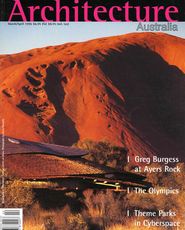
Photomontage of some proposed developments at Homebush. Image: Simon Kenny
In September 1995, two years after winning the Olympics 2000 for Sydney, the New South Wales government released the final masterplan for the Games facilities at Homebush Bay. Both the time taken to produce the proposal and the prosaic nature of the ultimate solution must be considered cause for grave concern. In design terms, the Sydney Olympics threaten to be a non-event. This is not the way the enterprise started. In 1993, the Sydney bid was hailed for its technical brilliance, new sports facilities were under construction at the Homebush site and the vision of a ‘green’ Olympics seemed to have some basis in reality, at least in terms of the Olympic Village scheme generated from the competition for an environmentally sustainable design. Yet shortly after the announcement of Sydney’s global triumph, the physical planning process began to unravel. On closer inspection, the new sports facilities turned out to be strangely isolated from each other. The Olympic Village scheme was abandoned in the face of commercial pressure. And decision processes aimed at avoiding decisions were firmly set in place by a state government demonstrably unsure of what to do.

Controversial Electricity pylons west of Haslam’s Creek. Image: Simon Kenny
Towards the end of 1994, there was a radical attempt by the NSW Property Services Group to redress this situation. An urban design studio, organised by Professor Lawrence Nield and Linda Gregoriou, brought together a distinguished group of designers, critics, academics and students from Australia and overseas to prepare speculative proposals for the Homebush Bay site. For reasons that have never been satisfactorily explained, the design proposals generated during this one-week exercise have never been made public. However, the exercise highlights the need for some form of masterplan to structure the land-use programme, transport options and physical designs for the site.

Remaining buildings beside the brickpit. Image: Simon Kenny
In due course, the Homebush Bay Authority appointed an urban design team to address this fairly fundamental task. Chaired by Professor Lawrence Nield, the team included Andrew Andersons, Oi Choong, Darrel Conybeare, Ken Maher and Philip Thalis. From the outset, however, the team was constrained by three factors: firstly, the Olympic Village site at Newington was already under study by rival development consortia and could not be subjected to serious rethinking. Secondly, the team was appointed in the middle of a change of government and found itself advising completely new political masters and in due course a new entity, the Olympic Co-ordination Authority. Thirdly, and perhaps most importantly, the whole enterprise was constrained by a set of stringent confidentiality agreements which eliminated all possibility of open discussion. As a result, a very long time was devoted to the production of a lacklustre scheme which left out the Olympic Village.

The Sydney International Aquatic Centre, by Philip Cox Richardson & Taylor, beyond existing industrial buildings. Image: Simon Kenny
This leaves Sydney with a major problem. Time has evaporated so there is no option but to continue with the scheme in its present state. The question is whether anything can be made of it. Unfortunately, the parallels and precedents which come to mind do not inspire great confidence. The most obvious point of reference is the Tuggeranong Town Centre which similarly turned to the grid as an ordering device, the street as a place of everyday activity, the perimeter building as a basic commercial type and the public institution as a considered object in the public realm. Yet downtown Tuggeranong conspicuously fails as a place. Built to the scale of the regional shopping centre and bus interchange which are embedded in its plan, Tuggeranong Town Centre stands as a parody of contextualism.

North-east wall of the aquatic centre. Image: Simon Kenny
The same fate awaits the Homebush Bay ‘urban core’ due to the fact that its scale has been set by the movement pattern of the Sydney bus fleet and the occasional surge of spectator crowds. It totally lacks the human scale of a lived environment because the possibility of integrating—interweaving—the Olympic Village with the Games facilities has not been considered. The residential component of the Olympic enterprise remains resolutely zoned out of range of human interest on the far side of Haslam’s Creek.

‘Legacy Plan’ for the post-Olympics period. Image: Simon Kenny
This weakens one of the major achievements of the urban design team, which was to guide the state government to a sensible decision on the rail connection to the site. An underground station serviced by a high capacity loop line has been designed to terminate a branch connection to the main metropolitan system. However, the railway station will be at least two kilometres from the village. A far more interesting, relevant and environmentally responsible solution would be to relocate the village to the immediate vicinity of the station and create an urban environment compatible to the South Paddington/ Centennial Park surrounds to the Moore Park stadia.

New bus shelter outside the State Sports Centre. Image: Simon Kenny
The conceptual flaw at the heart of the masterplan is that an ‘urban core’ is proposed without an urban programme. However, this could be addressed quite simply by integrating a significant residential component among the other land uses. Mixed-use housing at various densities would give definition, physical presence and human presence to the grid of tree-lined streets. As indicated by the ‘Legacy Plan’, an urban extension around the site of the abandoned brickpit would offer the possibility of a more dynamic engagement with the landscape of grasslands, wetlands and mangrove-fringed embayments.
Another disappointing aspect of the masterplan is that the urban design team has retreated from a poetic ambition to invoke the gods of Olympia. The reconstructed hillock at the western terminus of the main axis has been named the Hill of Kronos and the masterplan report ends with an appropriate quotation from Pindar. This appears to be all that is left of a set of classical references which sought to structure the site along the lines of the sanctuary and stadium at Olympia. This was a good idea which was worth keeping in the face of bureaucratic indifference, commercial opportunism and other prosaic determinants which have left the plan in its current state. The series of spaces set apart from the ‘urban core’ to celebrate supreme physical achievement need to be expressed in a totally distinctive way, heightened in significance beyond the norms of everyday experience. The whole concept of marking the bounds of a site, orchestrating the progression and movement through space, expressing the special qualities of human contest in space and time and capturing the moment of triumph deserve a commitment to design qualities of the highest order. To give the site of the great stadia the qualities of a temenos; to reconceptualise the stadia as highly charged sculptural elements positioned in space like temples of the 21st century; to evoke through spatial modulation the very feeling of the sacred sites of antiquity, would be to create a setting for the XXVII Olympiad worth all the effort. Instead we seem headed towards a suburban solution.

New marker tower for the Olympic precinct. Image: Simon Kenny
To transcend the ordinary, the masterplan needed a brilliantly conceived code of physical clues to guide development on the ground. Designers also needed time to work with these and with the distinctive qualities of the site. Instead, we have nothing more than a diagram to work with and no time to think. The design of the principal components of the plan—the main stadium and the Olympic village—appears to be incidental to the commercial potential of these projects. The decision to site the Royal Agricultural Society’s Showground at Homebush has created the illusion that urban qualities can be conjured from a programme of unprepossesing sheds. Themain gesture in the plan, the Olympic Boulevard, turns out to be an on-grade bus interchange. The conceptual clarity of the grid is weakened at every turn by awkward entry routes.
In the present state, the landscape of abandoned state enterprise at Homebush Bay has a peculiarly haunted quality. The remnants of the brickworks and the vast abbatoir which occupied the site for the greater part of this century carry strangely dislocated associations. Embedded in the masterplan are endless references to physical traces and cultural associations as determinants of the diagram. Yet the reality of the ‘urban core’ set in an extended matrix of metropolitan parkland must suggest otherwise. The palimpsest is a whimsical design device which cannot suggest much beyond its own arbitrariness. There can be no substitute for the spontaneous interaction of city life as it is lived. A scheme which diagrams major activities into discrete zones, turns away from human scale and places commercial values at its heart will have to work very hard to be any more successful than the New Town centres of the recent past.















